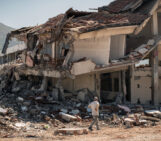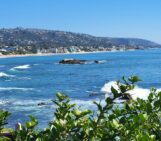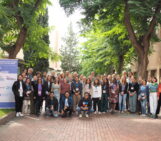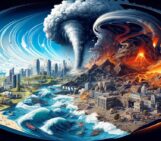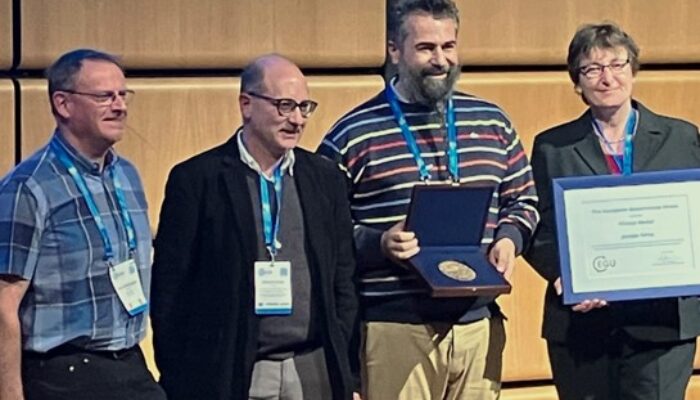
Jacopo Selva is an associate professor at the University of Naples Federico II, Italy, and a former researcher at the Istituto Nazionale di Geofisica e Vulcanologia (INGV), Italy. His research on seismic, volcanic, and tsunami hazards has been instrumental in advancing our understanding of these natural phenomena, particularly by developing probabilistic methods for hazard assessment and forecasting. Jacopo was awarded the prestigious Plinius Medal by the European Geophysical Union (EGU) in April 2024. This accolade celebrates interdisciplinary research and efforts to quantify and mitigate the risks associated with multiple natural hazards.
Good morning, Jacopo. Thank you for taking the time to answer my questions today. Congratulations on your well-deserved award! Your interdisciplinary contributions to the field of natural hazards forecasting are inspiring for our scientific community.
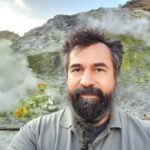
Solfatara of Campi Flegrei (Naples, Italy) during a visit with students in 2023
Like Pliny (Plinius), the elder himself, your career has been deeply intertwined with the study of different natural hazards. Can you share the story of how you were drawn to this field and what experiences shaped your research focus?
I graduated in Physics, with a specialisation in Geophysics. I have always had a passion for classical physics, for complex systems of interacting objects. Geophysics was perfect for this, and so I chose it as my specialisation. During the early stages of my PhD, I started facing the problem of uncertainty in seismological models, and little by little, I drifted toward the magical world of forecasting. I started with the evaluation of earthquake interaction, then, after my PhD, I moved to eruption forecasting… and eruptions generate hazards… so, the step toward volcanic hazard was very short! I started with volcanic hazards, but I could not stop myself from moving to next-door phenomena in Geoscience. So, when I had the opportunity, I extended to tsunami and seismic hazards, never abandoning my first passions, though, that is volcanology and statistical seismology!
One of your significant contributions to the field is the co-development of the Bayesian Event Tree (BET) framework for volcanic eruption forecasting and hazard assessment. Could you explain the central features of BET and share how it has improved the reliability and practical application of volcanic hazard assessments?
The model BET [1,2,3] provides a probabilistic framework for the event tree used by volcanologists to explore the potential outcomes of a volcanic crisis. BET introduced Bayesian statistics to quantify the probability of occurrence of the events described by the event trees, considering multiple sources of information and quantifying the uncertainty inherent to this quantification. The illusion of determinism, that is of perfectly previewing the evolution of the phenomena that we study, was, and to some extent still is, very diffuse in volcanology and, more in general, in (geo)science. BET, along with a few other initiatives, questioned determinism in volcanology and strengthened the way toward statistical eruption forecasting and probabilistic volcanic hazard, to be eventually linked to rational decision-making under uncertainty.
Your work integrates various data sources, physical models, and expert opinions into hazard and forecasting models. Can you elaborate on the importance of interdisciplinary collaboration and how it helped in developing the idea of probabilistic tsunami forecasting?
I have always tended toward interdisciplinary research. Mainly for curiosity, I think. Whenever I had the opportunity to investigate new phenomena and new ideas, I almost always chose to follow my curiosity and open a new research line. Often, the starting point was the possibility to solve an existing problem in one discipline using a method, or simply an idea, that was already used in another discipline. This opened the door to new problems, for which innovative solutions were required. The jump between eruption forecasting to probabilistic tsunami forecasting [4] for tsunami warnings is far shorter than one may think. It is uncertainty quantification of a potential hazard to inform decision-making. It is the will to communicate what we really know along with its limits, to allow for rational decision-making based on the real state of knowledge, and not on an illusion of knowledge that does not exist.
However, there is also the dark side of the story. Interdisciplinary work brings you often in uncomfortable positions, out of your safe zone. You find yourself in “another” community, which adopts other terms and has different conventions, and in which you often know people only by the names you read on scientific papers. Sometimes, it is difficult. However, in my personal experience, interdisciplinary work paid a lot, in terms of science, satisfaction, as well as of career. And I think that multidisciplinary is the future, in an every-day-more-connected world.
Often, scientific work can seem very theoretical. However, you have also directly contributed to improving emergency response strategies by working with Italian civil protection at multiple volcanic sites. What were your reflections when working on such initiatives that directly impact disaster preparedness or response for local communities? What challenges, implications, or key findings did you encounter?
When you work with decision-makers, you immediately realise how multi-faced are all practical problems. And you quickly understand that “your” hazard, the one that you chose to study and that filled your working life with, is not the only hazard, and often (always?) it is not even the most important. And that natural hazards are not the only problems that exist in a society!
When I had the opportunity to work with decision-makers, I had two contrasting feelings. On the one side, I was excited to think that I could contribute with my research to save people, help a community, and increase societal resilience to hazards. On the other side, I felt the responsibility for producing operational contributions, with a potential impact far beyond a research paper. In my perspective, this pushed me a lot toward communicating not only what we know, but also what we do not know. In other words, to communicate our forecasts along with how far we think we are from the truth, communicating certainties along with uncertainties. It looks complicated, but in many cases, it is not, as everyday life is full of uncertainty that we instinctively deal with, accounting for both certainties and uncertainties.
You’ve recently transitioned from institutional research to spending more time engaging with students at the university. How has this transition influenced your work and perspective? What do you enjoy most about teaching and mentoring the next generation of scientists?
Actually, to me, it worked in the opposite way. At the beginning of my career, I wanted to concentrate only on pure research. I wanted no distractions, just research. Teaching was a distraction. Coordination or mentoring were distractions, too, in my mind. At one point, I started realizing that pure research was a bit sterile, and that often, what I was doing was out of the horizon of the new generations. At that point, I started looking for opportunities to communicate to the new generation of researchers, with seminars and short courses. That was striking to me, as it opened a completely new way of seeing things! Because teaching forces you to continuously update yourself and your way of thinking things. Because teaching pushes you to update your points of view. Because the contact with students osmotically transmits passion in both directions, from teacher to students and vice versa. So, it was my research activity that pushed me toward this change. And I discovered again, after more than 20 years, why I chose to study geophysics!
Looking ahead, what do you see as the future challenges and opportunities in the field of natural hazards research? How do you envision your work evolving in the coming years? Or if you have any recent or upcoming research you are excited about
I think that our exploration of uncertainty in natural hazards is far from satisfactory. We need to work hard to define what we really do know. We still need to find many “unknown unknowns”, that is, things for which we are not even aware that our knowledge is still too limited. There are many unexplored (or under-explored) phenomena to study, like, for example volcanic tsunamis. Many steps forward are necessary in both volcanic and tsunami hazards, both in quantifying the hazards as well as in testing the forecasts. Multi-hazard risk still needs to be better explored. In all these fields, there are probably many missing elements and connections that we are not yet aware of, and that may allow us in the future to better understand and better forecast natural events. The increasing computational resources and the quickly improving artificial intelligence methods, along with our fundamental curiosity to understand things, will allow us to explore many still unexplored features of nature and find new potential sources of certainty and uncertainty. Even more importantly, they will probably change our way of thinking about problems, leading to new and existing questions to be solved.
For further insights on this topic, don’t miss Jacopo Selva’s inspiring award lecture from EGU24.
References
[1] Marzocchi W, Sandri L, Selva J. BET_EF: a probabilistic tool for long-and short-term eruption forecasting. Bulletin of Volcanology. 2008 Mar;70:623-32.
[2] Marzocchi W, Sandri L, Selva J. BET_VH: a probabilistic tool for long-term volcanic hazard assessment. Bulletin of Volcanology. 2010 Aug;72:705-16.
[3] Selva J, Costa A, Marzocchi W, Sandri L. BET_VH: exploring the influence of natural uncertainties on long-term hazard from tephra fallout at Campi Flegrei (Italy). Bulletin of Volcanology. 2010 Aug;72:717-33.
[4] Selva J, Lorito S, Volpe M, Romano F, Tonini R, Perfetti P, Bernardi F, Taroni M, Scala A, Babeyko A, Løvholt F. Probabilistic tsunami forecasting for early warning. Nature communications. 2021 Sep 28;12(1):5677.
Post edited by Soheil Mohammadi and Silvia De Angeli

